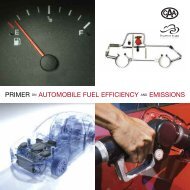<strong>Promot<strong>in</strong>g</strong> <strong>Green</strong> <strong>Power</strong> <strong>in</strong> <strong>Canada</strong> Pollution ProbeRenewable Stand Alone <strong>Power</strong> Supplysystems, w<strong>in</strong>d and w<strong>in</strong>d hybrid RenewableStand Alone <strong>Power</strong> Supply systems, microhydroRenewable Stand Alone <strong>Power</strong> Supplysystems, solar hot water, biomass co-fir<strong>in</strong>g,wave, ocean, fuel cells and hot dry rocks. Noteligible are: fossil fuels or waste productsderived from fossil fuels.Australia’s Susta<strong>in</strong>able Energy DevelopmentAuthority (SEDA) def<strong>in</strong>es renewable energyas the production of electricity, transport fuelor process heat from sources that don’t run out— sunsh<strong>in</strong>e, w<strong>in</strong>d, flow<strong>in</strong>g water and organicmaterial (biomass energy). Renewable energytechnologies <strong>in</strong>clude photovoltaics (solarpanelledpower systems), solar thermal, w<strong>in</strong>dturb<strong>in</strong>es, hydro power, wave and tidal power,biomass-derived liquid fuels and biomassfiredgeneration.The SEDA <strong>Green</strong> <strong>Power</strong> Program 6 def<strong>in</strong>esrenewable energy as energy derived fromsources that cannot be depleted or can bereplaced, such as solar, w<strong>in</strong>d, biomass, waveor hydro. Renewable sources will always beavailable and are essentially non-pollut<strong>in</strong>g.In addition, biomass electricity is def<strong>in</strong>ed asenergy from organic sources, <strong>in</strong>clud<strong>in</strong>glandfill gas, sewage gas and bagasse. Eachgeneration project is assessed on a case-bycasebasis, depend<strong>in</strong>g on its impact on theenvironment and its acceptance by thecommunity. For example, only susta<strong>in</strong>ableplantation <strong>for</strong>estry sources are acceptableunder the <strong>Green</strong> <strong>Power</strong> program — <strong>Green</strong><strong>Power</strong> is not sourced from old growth <strong>for</strong>estsor regrowth native <strong>for</strong>ests.British New Renewable Energy PolicyIn the document, New & Renewable Energy— Prospects <strong>for</strong> the 21st Century [GB 1999],the terms “renewable energy” and “renewableenergy source” are def<strong>in</strong>ed as follows:Renewable energy is the term used to coverthose cont<strong>in</strong>uous energy flows that occurnaturally and repeatedly <strong>in</strong> the environment.Renewable sources of energy are thosethat are cont<strong>in</strong>uously and susta<strong>in</strong>ablyavailable <strong>in</strong> our environment, such as w<strong>in</strong>dand solar energy. These sources producesignificantly lower levels of environmentalpollutants than conventional sources ofenergy; <strong>in</strong> particular, they generally emit nogreenhouse gases or are neutral over theirlife-cycle <strong>in</strong> greenhouse gas terms (<strong>for</strong><strong>in</strong>stance, energy crops produce carbondioxide when they are burnt, but the newcrop growth absorbs an equivalent amountof carbon dioxide from the atmosphere,mak<strong>in</strong>g the process as a whole neutral <strong>in</strong>carbon terms). Waste <strong>for</strong> which there is nomore economic use, such as recycl<strong>in</strong>g, canalso often be used as a fuel and achievesav<strong>in</strong>gs <strong>in</strong> fossil fuel use and reductions <strong>in</strong>CO 2emissions. New energy sources <strong>in</strong>cludetechnologies, such as fuel cells, whichconvert the energy of a chemical reaction,typically between hydrogen and oxygen(generally from air) directly <strong>in</strong>to low voltagedirect current electricity and heat. Thesusta<strong>in</strong>ability of renewables means that theywill cont<strong>in</strong>ue to be available even <strong>in</strong> thelonger-term future, when fossil fuel sourcesmay be gett<strong>in</strong>g scarcer.2.3.3 A Discussion of the Word“Renewable”Energy sources that are considered renewable<strong>in</strong> the orig<strong>in</strong>al sense of the word are hydroand ocean energy, w<strong>in</strong>d and solar energy.They are cont<strong>in</strong>ually renewed through abioticprocesses. As Box 2.2 (see Figure 4.14) shows,geothermal energy is not as renewable as theother <strong>for</strong>ms of energy and can be depletedlocally, although not globally. It should benoted, though, that some geothermal fields,like those <strong>in</strong> Italy, have been deliver<strong>in</strong>gelectricity <strong>for</strong> more than 90 years.Fossil fuels are derived from plant andanimal matter and are there<strong>for</strong>e also biomass— but as opposed to newly grown biomass,which can be regrown <strong>in</strong> a relatively shorttime, fossil fuel stocks cannot be replaced.18
<strong>Promot<strong>in</strong>g</strong> <strong>Green</strong> <strong>Power</strong> <strong>in</strong> <strong>Canada</strong> Pollution ProbeBiomass regrowth can occur naturally (e.g.,<strong>for</strong>ests) or artificially, through the plant<strong>in</strong>g oftrees or energy crops. Organic waste fromprocess<strong>in</strong>g plants or animals, as well as fromhousehold activities, is also a <strong>for</strong>m ofbiomass. The differences here are whether ornot growth-enhanc<strong>in</strong>g activities take place(extensive vs. <strong>in</strong>tensive agriculture), orwhether biomass is purposely grown <strong>for</strong> useas an energy fuel or whether it is a wastederived from other economic activities. Thema<strong>in</strong> difference between fossil and nonfossilenergy sources is that the non-fossilones require additional <strong>in</strong>put, apart fromsunlight, <strong>in</strong> the <strong>for</strong>m of nutrients that needto be replenished over time, either throughnatural processes or through the addition offertilizers. The use of biomass <strong>for</strong> energyproduction is also l<strong>in</strong>ked to air emissions,although the carbon cycle may be more orless closed, depend<strong>in</strong>g on the case.2.4 Conclusions About Exist<strong>in</strong>gDef<strong>in</strong>itionsBox 2.2 — Is Geothermal EnergyRenewable?Available data from the Cali<strong>for</strong>niaDepartment of Conservation’s Divisionof Oil, Gas and GeothermalResources and <strong>in</strong>dustry sources showthat operat<strong>in</strong>g capacity at The Geysershas decl<strong>in</strong>ed by about 30–40% (about700 MW) s<strong>in</strong>ce 1988, represent<strong>in</strong>gsome 5 billion kWh of lost generationfrom peak production levels. It isphysically impossible to reverse thisdecl<strong>in</strong>e, which, <strong>in</strong> colloquial terms,resulted from developers putt<strong>in</strong>g “toomany straws <strong>in</strong> the soda,” deplet<strong>in</strong>gthe naturally generated geothermalsteam at a much faster rate than theearth is able to renew it. The economicpractice of curtail<strong>in</strong>g production dur<strong>in</strong>gthe w<strong>in</strong>ter and spr<strong>in</strong>g has the sidebenefit of slow<strong>in</strong>g the rate of decl<strong>in</strong>e ofthe resource [RADER 1998, p. 17].2.4.1 “Conventional” vs. “Alternative”There is little disagreement that “conventional”power sources <strong>in</strong>clude energy productionfrom fossil fuels and nuclear energy. Somecontroversy has developed as improvedtechnologies come <strong>in</strong>to play. For example,co- or trigeneration, fluidized bed, very highefficiency gas, and co-fir<strong>in</strong>g of biomassimprove the environmental per<strong>for</strong>mance ofconventional sources, but do not necessarilyturn them <strong>in</strong>to alternative sources.Clarification is also needed concern<strong>in</strong>g largeand small hydropower generation. Largehydropower, although clearly renewable, isoften seen as unsusta<strong>in</strong>able due to itsdamag<strong>in</strong>g effects on ecosystems. Small hydroplants are generally seen as “green” powersources, although their life-cycle impacts canbe higher, especially if they have a reservoir,as opposed to run-of-river hydro. However,the delimitation of small and large hydro isunclear. It has often been based solely on thegeneration capacity of power plants, but thethreshold has varied from one country toanother (generally, it lies between 10 and 30MW). Recently, the tendency has been toassess the effects of a plant accord<strong>in</strong>g toenvironmental and social criteria, replac<strong>in</strong>gthe <strong>for</strong>mer evaluation scheme based oncapacity. Whereas non-emitt<strong>in</strong>g powersources, such as large hydro and nuclear, aresometimes called “clean,” they haveenvironmental and societal problemsattached to them that disqualify them frombe<strong>in</strong>g considered “green.” Also, they do notneed the f<strong>in</strong>ancial support mechanismscurrently discussed to promote green powersources.19
















